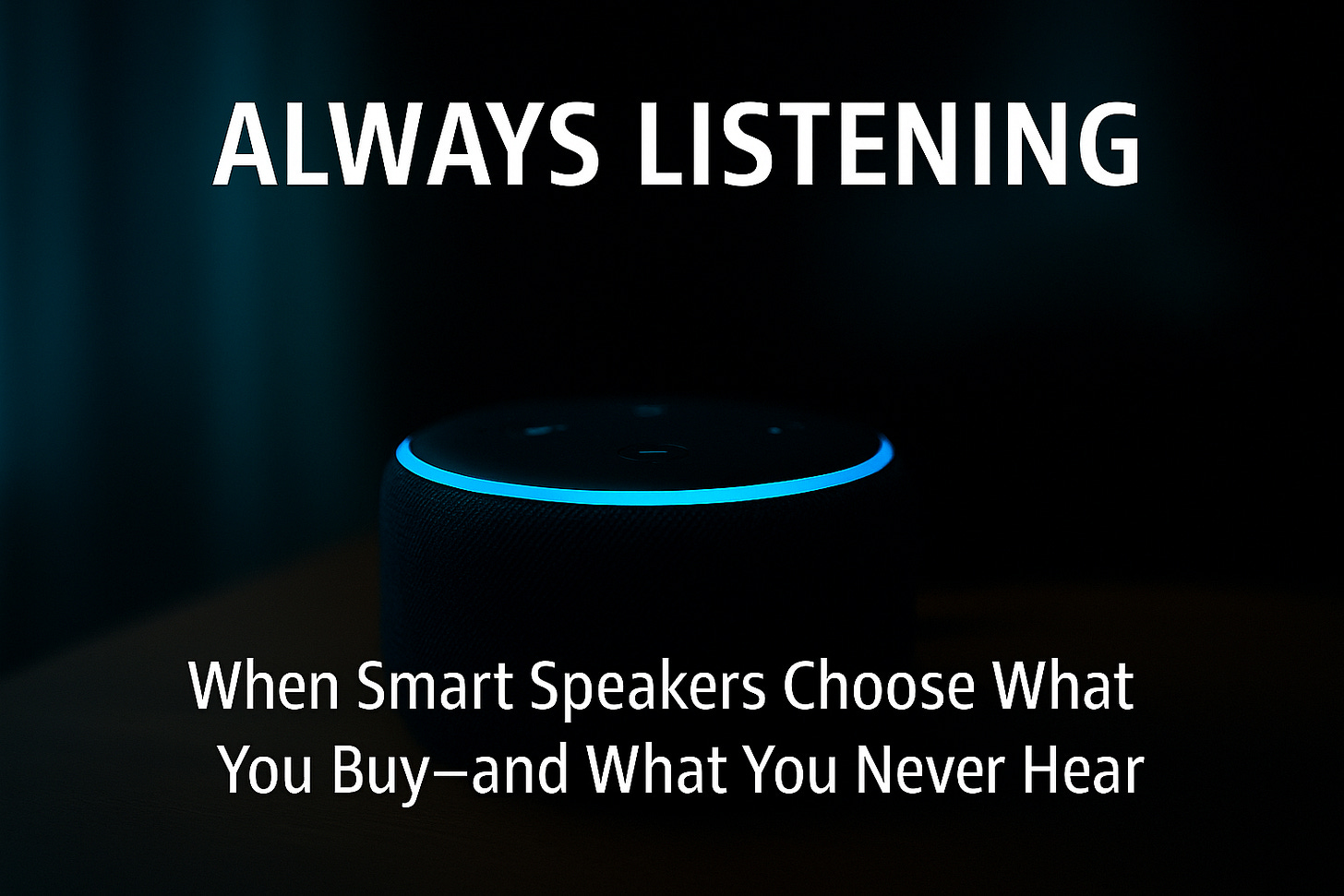Signal Capture
A six-year-old in Arkansas asks Alexa for cookies. Two days later, a bulk pack of Oreos lands on the doorstep—no screens, no ads, no decisions. Just a voice command, and a transaction is complete.
It’s a funny story until you realize what really happened:
Decades of marketing touchpoints—ads, reviews, comparisons—collapsed into a single spoken request. No choices offered. No competition visible.
When your assistant picks the brand, did you ever choose at all?
System Snapshot: Your Helpful Assistant Has a Boss
Think of your voice assistant—Alexa, Google Nest, or Siri—as a personal concierge. You ask for something, and it delivers.
But here’s the catch:
That concierge doesn’t work for you. It works for the platforms—and for the brands paying for placement, shaping what you hear, and quietly erasing what you don’t.
By 2025, more than 500 million smart speakers sit in homes worldwide. In the U.S., 40% of households live with an always-on microphone (Voicebot.ai, 2024). These devices have quietly reprogrammed how commerce works:
Always Listening: Devices buffer audio, waiting for "Alexa" or "Hey Google." But “waiting” doesn’t mean “off.”
Cloud Processing: Once triggered, your voice is sent to remote servers where algorithms decide what you really meant.
Skill Ecosystems: Brands build voice apps to insert themselves into those responses.
Zero-Interface Commerce: There’s no screen, no scroll—just “Order detergent,” and it’s done. But which detergent? The system decides.
The result:
The traditional act of choosing has collapsed into a single answer—one you’re never invited to question.
Tactical Dynamics: How Brands Hijack Your Voice
Marketers saw the shift early. Here’s how they adapted to the invisible funnel:
• The “One Answer” Rule
Say, “I’m out of coffee.” Alexa doesn’t show you brands. It picks one—based on your past behavior, its internal priorities, or quiet commercial deals.
• Algorithm-Approved Product Design
Companies now design product names to be easily understood by voice assistants. If the system can’t recognize the name, your product doesn’t exist.
• Every Word Is Data
Every reminder, list item, or command trains a predictive engine. Despite laws like CPRA and the EU Digital Markets Act, platforms still collect enough behavioral signal to anticipate what you’ll say—and who will benefit.
Threat Matrix: What You Don’t See (or Hear)
The system may feel effortless, but its control mechanisms are anything but neutral:
Misheard Commands: Kids order toys. Background conversations trigger purchases.
Default Brand Bias: Ask for batteries, get AmazonBasics. Google favors partners.
Silent Monopoly: When only one result is served, competition disappears.
Regulatory Scrutiny: Antitrust investigations are underway—but enforcement lags behind the tech.
Still, none of these are the real elephant in the room.
The Listening Illusion: Are They Really Always Listening?
You talk about something near your phone or smart speaker—and suddenly, ads appear. Big Tech says it’s coincidence. But multiple investigations suggest otherwise.
Bloomberg (2019) revealed Amazon employees reviewed Alexa recordings—including those captured without the wake word.
The Guardian (2019) found Apple and Google contractors listening to sensitive Siri and Assistant recordings.
Facebook and Instagram deny using microphones for ad targeting—but retain broad mic permissions on many devices.
Here’s what’s actually happening:
Devices often capture more than they disclose—through false triggers or vague terms of service.
Even when not actively recording, platforms link your speech, location, browsing, and habits to build behavioral models.
With enough data, they don’t have to spy.
They already know.
Protocol One Insight
“When the mic is always on, the difference between listening and recording is just a legal definition.”
Spot the System: Voice Assistant Red Flags
You ask for a product and only get one answer.
"Suggestions" conveniently favor Amazon, Google, or their partners.
You start seeing ads for things you’ve only spoken about.
You’re nudged into reorders—without ever seeing alternatives.
If convenience feels automatic, ask who programmed your autopilot.
Operator Protocol: Outsmarting Your Smart Devices
You don’t have to fear your assistant—but you shouldn’t trust it blindly either. Here’s how to regain control:
Audit Your Defaults
Check what your assistant auto-recommends. Disable “preferred brands” and reordering features when possible.Restrict Microphone Access
On phones, set mic access to “only while using the app.” Regularly purge your voice assistant’s history.Be Specific
Vague commands like “Order paper towels” let the system choose. Saying “Order Bounty 12-pack” limits its options.Mute When Not in Use
Hit the mic-off button when not speaking to your device—especially during private conversations.Stay Intentional
Every command reinforces a behavior pattern. Use these systems deliberately—not passively.
Clear thinking is your best firewall.
Final Transmission: The Cost of Convenience
Every time you say “Hey Google” or “Alexa,” you’re not just interacting with a helpful tool. You’re entering a curated system—one designed to filter your inputs, predict your actions, and monetize what you don’t notice.
Like a concierge who never tells you about the better restaurant because someone paid him not to—you’re not being helped. You’re being steered.
You don’t need paranoia.
You need pattern recognition.
So the next time your assistant answers, ask yourself:
Who decided what you didn’t hear?
Convenience isn’t free—it’s paid for in invisible choices.
[FIN/ACK]
Transmission Complete
Process Accordingly
—Protocol One
If this drop helped you understand the machinery running behind the screen, consider buying me a coffee.
Your support keeps these breakdowns sharp, clear, and immune to corporate influence.
☕ Support the work: buymeacoffee.com/protocolone
Citations
Bloomberg (2019): Amazon Workers Are Listening to What You Tell Alexa
The Guardian (2019): Apple Contractors Hear Confidential Details on Siri Recordings
Voicebot.ai (2024): Smart Speaker Adoption Statistics
IAPP.org: Summary of CPRA & EU Digital Markets Act



